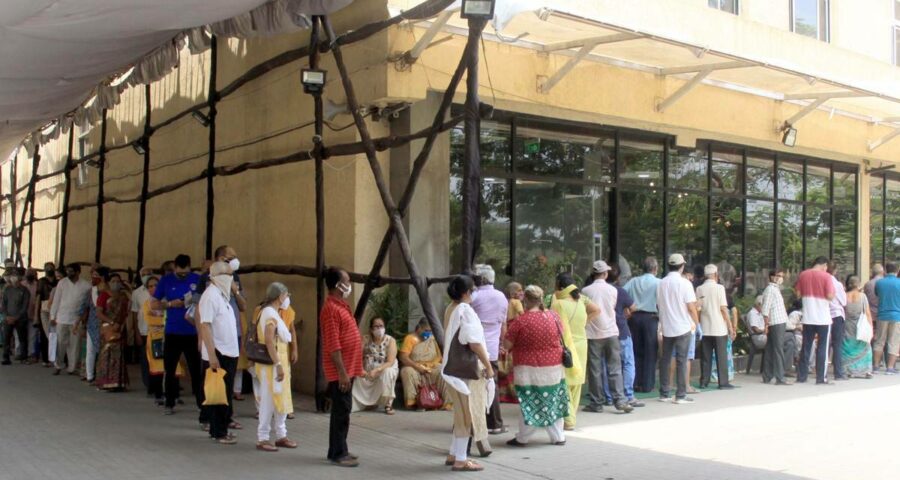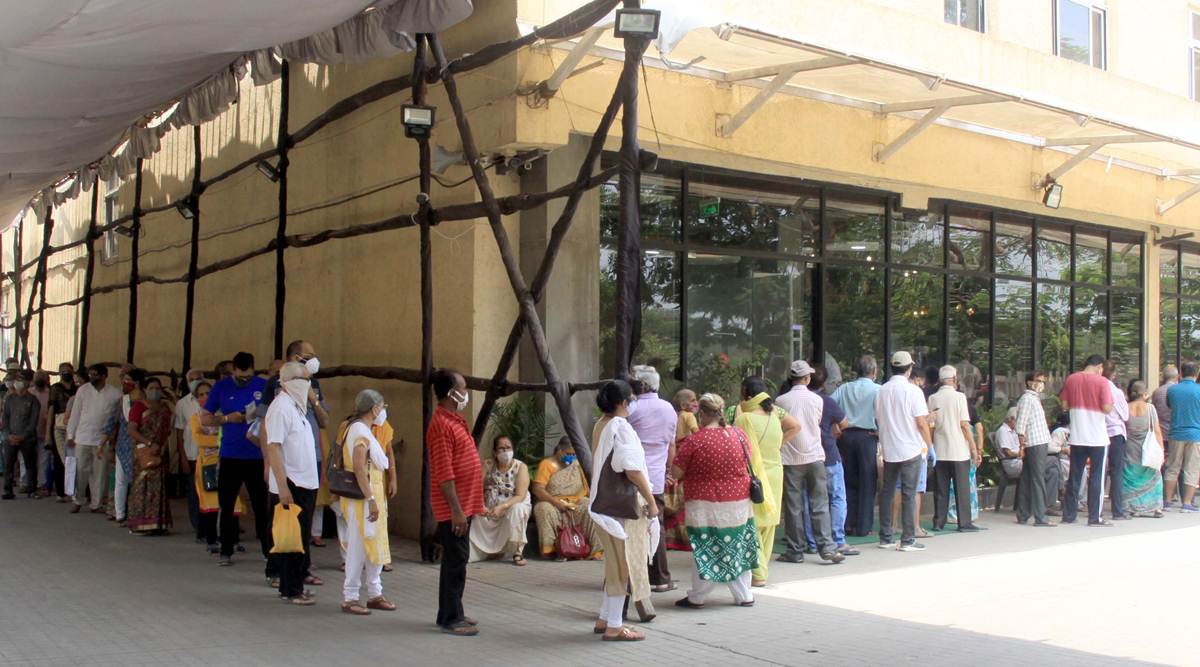India has largely been reliant on a real-time supply of vaccines from essentially a duopoly of suppliers.
The big-bang — and much-awaited — announcement Monday to expand vaccinations to those above 18 gives the already strained machinery, fighting the rising Covid wave, all of 10 days to gear up for the logistical challenge. Of course, the 600 million now eligible are expected to be staggered by states depending on profile and stocks, but the short lead time is reflective of most milestones in the Centre’s vaccine policy.
Beginning with January 11 this year, when it placed its first set of orders for vaccines, just five days before the campaign was rolled out.
This is in sharp contrast to other countries which stockpiled their vaccines before launching the inoculation blitz. As early as May 2020, countries like the US began stockpiling through “at risk” investments in multiple manufacturers. Throughout last year, the UK ended up taking such at-risk options in all seven vaccines developed across the world. With an order for 400 million vaccine doses, it has evidently been “one of the world’s highest per-capita buyers” of vaccines. It is now on track to have more than 100 million surplus doses in due course. Israel followed another model: striking a deal with Pfizer to share medical data of inoculated people in exchange for the continued flow of Pfizer’s vaccine.
India, in contrast, has been largely reliant on a real-time supply of vaccines from essentially a duopoly of suppliers. The first official sense came October 4 when Health Minister Dr Harsh Vardhan said around 200-250 million people could expect jabs by July 2021. And by November, the government was confident of being able to vaccinate 300 million people by August 2021 – this would require around 600 million doses of a two-dose vaccine.
Yet, starting from March 2021, the government’s immunization programme had begun to stall. Amid a pinch in supply, on March 17, the CEO of Serum Institute of India, which is manufacturing Covishield, Adar Poonawalla said the government had “changed its view and mind” about how many doses it wanted to consume. This meant the Pune firm had to dedicate “a lot” of its capacity that was “not originally planned” for India as a result, he told Bloomberg.
Despite this, by the first week of April, states began reporting a shortage of vaccine supplies. On April 7, Maharashtra Health Minister Rajesh Tope said the state had vaccines to last just three days. Rajasthan, too, flagged it was running out of vaccination supplies on April 15. On April 18, Telangana Health Minister Etela Rajender said the state had decided to temporarily halt its vaccinations due to a shortage in supplies from the Centre.
At the same time, the capacity of Covaxin, the only other vaccine being used in the country’s immunization programme, was slow to pick up. Experts said this underlines how the government, despite having time to plan ahead, did not ensure a sufficient stockpile of Covid-19 vaccines in advance to streamline the push.
“All indications are that the government failed to place advanced purchase orders from vaccine manufacturers, and the initial supplies of these companies got locked into contracts that they had already signed with other countries like the US and UK,” said R Ramakumar, a professor at Tata Institute of Social Science’s Centre for Study of Developing Economies.
With supplies short of projected demand, the government plan was focused on vaccinating priority groups in a phased manner — healthcare workers first, followed by frontline workers like police and armed forces. In pursuance of this goal, the government had increased its total order of vaccines to 41 million doses by February 12, as per a response by Minister of State for Health Ashwini Kumar Choubey in the Lok Sabha response.
Vaccinations were opened up on March 1 for senior citizens and those above 45 years of age who had specific comorbidities. By March 17, a total of 70.62 million doses of Covid-19 vaccines had been supplied by the Centre, of which 37.10 million doses had been administered across the country.
By the time vaccinations were opened up for those above the age of 45, experts and industry executives said, there was a switch in the government’s supply-driven push to get people vaccinated. “Starting April 1, there was a higher rush in those above 45 wanting to get vaccinated, so there was a demand-driven pull for more vaccines,” said the official of an industry body on condition of anonymity.
At the same time, the country was banking on limited supply from just two vaccines — SII’s Covishield, and Bharat Biotech’s Covaxin. Some experts feel this could have been avoided if the country had not potentially been focused on pushing a narrative of being able to fulfil its demand through a “Made in India” shot.
India’s support to especially indigenous vaccines during the pandemic was mostly limited to the development and testing of these jabs. At the same time, unlike other countries, India neither funded at-risk production nor placed advance orders for the Covid-19 vaccines being developed here.
Some vaccine vial and syringe manufacturers told The Indian Express that as late as December, they were still in the dark on whether and how much of their capacities they had to earmark for vaccine-makers, especially since vaccine companies themselves had not received clarity on how many doses would be required.
This lack of at-risk funding or risk-sharing was pointed out by some industry executives towards the end of last year as a potential hurdle to investing in stockpiling doses. With supplies running short, the government did a rethink.
On December 4, Pfizer India was the first company to approach the Central Drugs Standard Control Organization (CDSCO) for restricted emergency permission to supply the Covid-19 vaccine it developed with German firm BioNTech. The day after, SII rushed to CDSCO with its emergency use request for Covishield. On its heels was Bharat Biotech, seeking similar permission to supply Covaxin despite not having completed Phase 3 trials.
On January 3, the country’s top drug regulator cleared Covishield and Covaxin for restricted emergency use in India.Pfizer, which had received an EUA in the UK for its vaccine, in January told Reuters that it wanted India to place orders for its vaccine despite constrained global supplies.
However, the vaccine maker’s request was rejected in February as it had not conducted local trials of the jab in India — a decision India has now effectively reversed in the hopes of attracting more applications for foreign Covid-19 vaccines, including Pfizer’s, which the company withdrew after its rejection in February.
Over the months, SII had reportedly been supplying most of its production capacity towards India’s vaccination programme, despite prior global commitments.
As of early April, The Indian Express had learnt that Bharat Biotech’s annual capacity for making Covaxin stood at 200 million – nearly 17 million doses a month.
Work to bring an additional Bio Safety Level 3 (BSL 3) facility online in Bengaluru has been underway with the country’s regulator having cleared the company to make test batches of Covaxin there. Sources said these batches are expected by the end of April, but even after an approval is given to the site, it is expected to take around 60 days for production to start.
The company had reportedly sought around Rs 75 crore from the government to help speed up its work at this facility. The government Friday announced that it was providing the company around Rs 65 crore in funding to help it repurpose this facility, which was originally intended to produce animal vaccines.
Source: Read Full Article


